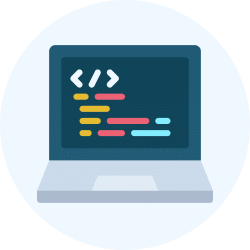Setting Up VS Code for C++ | Basics of C++ - Software Development PDF Download
Introduction
C++ is a powerful programming language used for developing applications, games, and system software. Visual Studio Code (VS Code) is a lightweight, yet powerful editor that supports C++ development through extensions. This guide will help you set up and write your first C++ program using VS Code.
Step 1: Install VS Code
1. Download VS Code
- Visit the official Visual Studio Code website
- Download the appropriate version for your operating system (Windows, macOS, or Linux)
- Install it following the on-screen instructions
2. Launch VS Code
- Open Visual Studio Code after installation.
Step 2: Install C++ Compiler
To run C++ programs, you need a compiler. The most commonly used compiler is MinGW for Windows and GCC (G++) for macOS/Linux.
Windows Users:
- Download MinGW-w64 from Mingw-w64 SourceForge
- Install MinGW and select g++ as the C++ compiler.
- Add MinGW to the system PATH:
- Open System Properties > Advanced > Environment Variables
- Under "System Variables", find Path, click Edit, and add C:\MinGW\bin (or wherever MinGW is installed).
- Verify installation by opening Command Prompt and running:
g++ --version
macOS/Linux Users:
For macOS and Linux, you can install the GCC compiler using:
sudo apt update && sudo apt install g++ # Ubuntu/Debian
brew install gcc # macOS
Verify installation:
g++ --version
Step 3: Install C++ Extension in VS Code
- Open VS Code.
- Go to the Extensions Marketplace (Ctrl + Shift + X or Cmd + Shift + X on macOS).
- Search for C/C++ and install the extension by Microsoft.
- Restart VS Code after installation.
Step 4: Create a C++ Project
- Open VS Code and create a new folder (e.g., CPP_Projects).
- Inside VS Code, open the folder (File > Open Folder > Select CPP_Projects).
- Create a new file named main.cpp inside the folder.
Step 5: Write a Simple C++ Program
Copy and paste the following C++ code into main.cpp:
#include <iostream>
using namespace std;
int main() {
cout << "Hello, C++ on VS Code!" << endl;
return 0;
}
Step 6: Configure and Run C++ in VS Code
1. Open Terminal
Go to Terminal > New Terminal
2. Compile the Program
In the terminal, navigate to the folder containing main.cpp and run:
g++ main.cpp -o main
3. Run the Executable
- On Windows:
- main.exe
- On macOS/Linux:
- ./main
Expected Output:
Hello, C++ on VS Code!
Step 7: Debugging in VS Code
To debug C++ programs in VS Code:
- Install C/C++ Extension Pack (if not already installed).
- Set up Launch Configuration:
- Go to Run > Add Configuration
- Select C++ (GDB/LLDB) for Linux/macOS or C++ (Windows) for Windows.
- This creates a .vscode/launch.json file.
- Set a Breakpoint:
- Click on the left margin of the line where you want to pause execution.
- Start Debugging:
- Press F5 to run the debugger.
- Use the debug toolbar to step through the program.
Conclusion
Congratulations! You have successfully set up C++ on VS Code. You can now write, compile, and debug C++ programs efficiently. Try experimenting with more C++ features and build exciting projects!
|
71 videos|48 docs|15 tests
|
FAQs on Setting Up VS Code for C++ - Basics of C++ - Software Development
| 1. What are the system requirements for setting up VS Code for C++ development? |  |
| 2. How do I install the C++ extension for VS Code? |  |
| 3. How do I configure the build system for C++ in VS Code? |  |
| 4. Can I debug C++ programs in VS Code? |  |
| 5. What are some common issues when setting up VS Code for C++ and how can they be resolved? |  |
















